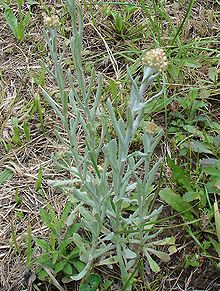- Helichrysum luteoalbum
-
Helichrysum luteoalbum 
Scientific classification Kingdom: Plantae (unranked): Angiosperms (unranked): Eudicots (unranked): Asterids Order: Asterales Family: Asteraceae Genus: Helichrysum Species: H. luteoalbum Binomial name Helichrysum luteoalbum
(L.) Rchb.Synonyms Gnaphalium luteoalbum L.
Pseudognaphalium luteoalbum (L.) Hilliard & B.L.BurttHelichrysum luteoalbum, commonly known as Jersey Cudweed or Weedy Cudweed, is a cosmopolitan weed.
Contents
Description
It grows as an erect herb up to 70 centimetres high, branching from the base. Flowers are cream, yellow, white, or pink.[1]
Taxonomy
This species was first published by Carl Linnaeus in his 1753 Species plantarum, under the name Gnaphalium luteo-album (the orthography was later changed to omit the hyphen). In 1829, Ludwig Reichenbach transferred it to Helichrysum, but this name was not taken up, and the species was retained in Gnaphalium until 1981, when Olive Mary Hilliard and Brian Laurence Burtt transferred it into Pseudognaphalium.[2][3]
In 2004, an investigation into the phylogenetic relationships of Helichrysum and related genera found this species to have arisen within Helichrysum. As a result of this, Reichenbach's long-forgotten name for this species was resurrected.[4]
Distribution and habitat
This species is so widely distributed that it is unclear where it is native and where naturalised. In general it is considered naturalised in North and South America, and native to every other continent.[5]
See also
References
- ^ "Helichrysum luteoalbum (L.) Rchb.". FloraBase. Department of Environment and Conservation, Government of Western Australia. http://florabase.dec.wa.gov.au/browse/profile/29594.
- ^ "Gnaphalium luteoalbum L.". Australian Plant Name Index (APNI), IBIS database. Centre for Plant Biodiversity Research, Australian Government. http://www.anbg.gov.au/cgi-bin/apni?taxon_id=60679.
- ^ "Pseudognaphalium luteoalbum (L.) Hilliard & B.L.Burtt". Australian Plant Name Index (APNI), IBIS database. Centre for Plant Biodiversity Research, Australian Government. http://www.anbg.gov.au/cgi-bin/apni?taxon_id=33305.
- ^ Galbany-Casals, M.; et al. (2004). "Phylogenetic relationships in the Mediterranean Helichrysum (Asteraceae, Gnaphalieae) based on nuclear rDNA ITS sequence data". Australian Systematic Botany 17 (3): 241–253. doi:10.1071/SB03031.
- ^ "Pseudognaphalium luteoalbum (L.) Hilliard & B. L. Burtt". Germplasm Resources Information Network (GRIN) online database. http://www.ars-grin.gov/cgi-bin/npgs/html/taxon.pl?411038.
Categories:
Wikimedia Foundation. 2010.
